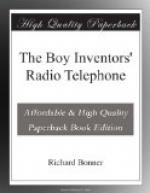“I had, therefore, to invent my own alternator, which is attached to that gasoline motor. There is a similar one in the shed from which you just talked with me.”
“But why does radio telephony require a stronger current than wireless telegraphy?” Tom wanted to know.
“Because, up to the present, no way has been found of utilizing in radio telephony the entire energy of the electric waves sent out,” replied Professor Chadwick. “Only the variations in the waves can be detected, or transformed into sound at the receiving end of a radio telephone system. Therefore an immense amount of electrical energy has to be manufactured in order that the voice vibrations may register their variations as powerfully as possible.”
“What percentage of the electrical energy manufactured by a high frequency alternator can be transformed into variations of sound?” asked Jack.
“Not more than five to eight per cent. of the total energy. So therefore the waste is enormous. In wireless telegraphy, on the other hand, the entire energy radiated from a sending station can be picked up to the limit of the receiver’s capacity to detect it.”
“Isn’t there any way in which this difficulty could be overcome?” inquired Tom.
“Yes, there is,” said Mr. Chadwick, after a moment’s thought, “and I believe that I am the only man in the world employed with radio telephonic problems who knows of it.”
“Why can’t you use it, then?” asked Jack.
“Because there are almost insurmountable difficulties in the way. There is a substance chemically known Z. 2. X. which, if it could be applied to purposes of transmission and detection, has such immense powers of electrical absorption that messages could be sent almost any distance, and with far greater economy of power than at present.”
“How far can you send them now?” asked Jack.
“About five miles. At least I think so. I’m not even sure of that,” was Mr. Chadwick’s reply.
But Jack was impatient to get back to Z. 2. X.
“Why can’t you use this Z. 2. X.,” he questioned, “if it would practically wipe out your troubles in sending and receiving?”
“Because there is even less of it in the world than there is of radium,” was the startling reply. “At present Z. 2. X. costs far more than radium. It is the most intensely radio-active stuff in the world. It is capable of being wrought into metal if anybody had ever found enough of it, but except for a small deposit in South Africa, which has been devoted to experimental purposes, nobody has any.
“But enough of that now. That is only a dream. I am anxious, though, to test out my present apparatus thoroughly, and to do it I shall need the help of you boys.”
“In what way?” asked Jack.
“In giving it a thorough trial to ascertain over how great a space I can transmit wireless speech.”
“Are you going to put up another station outside the grounds?” asked Tom.




